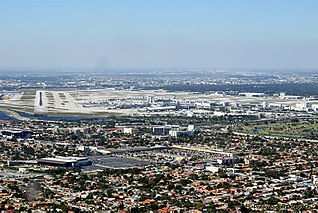History
This airport was built in the 1930s, during Trujillo's government, with the major purpose of stimulating the city's growth. The operations were focused on passenger movements between San Juan and Santiago, and also cargo operations to San Juan, Santo Domingo and Port-au-Prince. Before ceasing operations, Dominicana de Aviación became the first airline to connect Santiago with the United States, starting operations between Santiago and Miami, in McDonnell Douglas DC-6 aircraft in the 1970s.
In the 1990s, another Dominican airline, Dominair, started operations in the airport, with two daily flights to San Juan. They added flights to Port-au-Prince three years later. In 1998 the airport had its biggest expansion ever. They enlarged the runway to support operation of the American Eagle's ATR aircraft. The airport remained closed for at least eight months. In 1999 American Eagle started, for the first time, operations in Santiago, adding two daily flights to San Juan, making Dominair to leave the route.
In 2002 the airport closed its doors to the public due to the inauguration of a bigger airport, Cibao International Airport, located 15 minutes away from the city center. This new airport allowed jet-passenger aircraft operations and could receive flights from New York, Miami and San Juan, which Santiago Municipal Airport could not handle. On March 18, 2002, the two American Eagle flights to San Juan were transferred to the new Cibao International Airport, ceasing passenger operations in Santiago Municipal Airport. A Year later the Santiago Air Base became unnecessary for the FAD, and a cost that they could not handle by themselves, so they moved all operations to the Puerto Plata Air Base (located in Gregorio Luperon International Airport). Santiago Municipal was now completely closed, with no operations at all. Santiago Municipal Airport is now known as Cibao Center National Police, north command of operations for the National Police.
The Central Park of Santiago is projected to be constructed on the land of the now defunct old Santiago Municipal Airport that now lodges the regional seat of the National Police and the offices of the Association for Development. The industrialists of Santiago have defended the project since it is considered to be a solution to the lack of green spaces suitable for relaxation in the city. Nevertheless, it has been argued that the granting of contracts for the different phases from this project violate the frame of transparency and legality. In the Strategic Plan of Santiago it is indicated that the construction of the Metropolitan Park would increase the Santiagos green area from its current 1.1% to 4%. While the old military side of the airport is now used for the National Police, the old passenger terminal side is now used as a racetrack.

Transport in the Dominican Republic utilizes a system of roads, airports, ports, harbours, and an urban railway.

Luis Muñoz Marín International Airport (LMM), previously known as the Isla Verde International Airport, is the primary international airport of Puerto Rico serving the capital municipality of San Juan and its metropolitan area. Covering 1,600 acres, SJU is located in the beach-front district of Isla Verde in the municipality of Carolina. Named after Luis Muñoz Marín, the first elected governor of the archipelago and island, it is, as of 2023, the 39th busiest airport by passenger boarding, 28th by international passenger traffic, and 24th by cargo throughput in the United States or its territories. With 12,197,553 million passengers in 2023, SJU is the busiest airport in the Caribbean, where it serves as a major gateway into the region.

José Martí International Airport, sometimes known by its former name Rancho Boyeros Airport, is an international airport located in the municipality of Boyeros, 20 kilometres (12 mi) southwest of the centre of Havana, Cuba, and is a hub for Cubana de Aviación and Aerogaviota, and former Latin American hub for the Soviet airline Aeroflot. It is Cuba's main international airport, and serves several million passengers each year. The facility is operated by Empresa Cubana de Aeropuertos y Servicios Aeronáuticos (ECASA).

Miami International Airport — also known as MIA and historically as Wilcox Field — is the primary international airport serving Miami and its surrounding metropolitan area, in the U.S. state of Florida. It hosts over 1,000 daily flights to 185 domestic and international destinations, including most countries in Latin America. The airport is in an unincorporated area in Miami-Dade County, 8 miles (13 km) west-northwest of Downtown Miami, in metropolitan Miami, adjacent to the cities of Miami and Miami Springs, and the village of Virginia Gardens. Nearby cities include Hialeah, Doral, and the census-designated place of Fontainebleau.
Compañía Dominicana de Aviación, usually shortened to Dominicana, was an airline based in the Dominican Republic and served as the flag carrier for the country.

Nuevo Continente was a passenger airline based in Lima, Peru, operating scheduled domestic and international flights out of Jorge Chavez International Airport.

On February 15, 1970, a Dominicana de Aviación McDonnell Douglas DC-9 enroute from Santo Domingo, Dominican Republic to San Juan, Puerto Rico crashed into the Caribbean Sea shortly after takeoff. The crash killed all 102 passengers and crew on board, making it the deadliest aviation disaster to occur in the Dominican Republic until 1996 when Birgenair Flight 301 also crashed into the Caribbean Sea, leaving 189 dead.

Las Américas International Airport is an international airport located in Punta Caucedo, near Santo Domingo and Boca Chica in the Dominican Republic. The airport is run by Aeropuertos Dominicanos Siglo XXI (AERODOM), a private corporation based in the Dominican Republic, under a 25-year concession to build, operate, and transfer (BOT) six of the country's airports. Las Américas usually receives a wide variety of long-, mid-, and short-haul aircraft. Santo Domingo's other airport, La Isabela, is much smaller and used by smaller aircraft only.

Santiago de los Caballeros, often shortened to Santiago, is the second-largest city in the Dominican Republic and the fourth-largest city in the Caribbean by population. It is the capital of Santiago Province and the largest major metropolis in the Cibao region of the country. Santiago is the largest Caribbean city that is not a capital city, and it is also the largest non-coastal metropolis in the Caribbean islands. The city has a total population of 771,748 inhabitants (2022). Santiago is located approximately 155 km (96 mi) northwest of the capital Santo Domingo with an average altitude of 178 m (584 ft).
Aeromar Líneas Aéreas Dominicanas was an airline based in the Dominican Republic.

Aero Caribbean was an airline based in Vedado, Plaza de la Revolución, Havana, Cuba. It operated scheduled domestic and international passenger services, and charter flights mainly within the Caribbean and South America. Its main base was at José Martí International Airport, Havana.

Executive Airlines, Inc. was a Puerto Rican-based regional airline headquartered at Luis Muñoz Marín International Airport in Carolina, Puerto Rico, the main airport for the United States territory, near the capitol of San Juan. The airline was a wholly owned subsidiary of the AMR Corporation and it was paid by fellow AMR member American Airlines to staff, operate and maintain aircraft used on American Eagle flights that were scheduled, marketed and sold by American Airlines. Executive Airlines operated an extensive inter-island network in the Caribbean and the Bahamas from its hub in San Juan.

La Romana is a municipality and capital of the southeastern province of La Romana, opposite Catalina Island. It is one of the 10 largest cities in the Dominican Republic with a population estimated in 2022 at 153,241 within the city limits, of whom 149,840 are urban and 3,401 are rural. The name Romana comes from the word "Bomana", a name given by Indians to what is known today as Romana River.

Cibao International Airport, also known as Santiago Airport, is located in Santiago de los Caballeros, Dominican Republic's second-largest city. It is the country's third-busiest airport by passenger traffic and aircraft movements, after Punta Cana International Airport and Las Américas International Airport. The airport is located 15 kilometers (9.3 mi) southeast of Santiago City's center.

Toussaint Louverture International Airport is an international airport in Tabarre, a commune of Port-au-Prince in Haiti. The airport is currently the busiest in Haiti and is an operating hub for Sunrise Airways. It is informally called "the Maïs-Gâté airport", named after the area in the Cul-de-Sac Plain where the airport was built.

PAWA Dominicana was the international flag carrier of the Dominican Republic. It was created as a subsidiary airline for Pan American Airways. This airline had scheduled flights between Santo Domingo and other Caribbean and US destinations. It was based at Santo Domingo-Las Americas.
Air Dominicana was the flag carrier airline for the Dominican Republic. It planned to begin operations in October 2009 using a Boeing 737-400 aircraft with daily services to New York City and Miami. A second Boeing 737 was due to join the fleet later. Its headquarters were on the fourth floor of the Air Europa building in Santo Domingo.
Aerolíneas Mas was an airline with its corporate headquarters in the Ciudad Universitaria in Santo Domingo, Dominican Republic. It offered flights to several domestic destinations. Its flight operations were based at La Isabela International Airport in Santo Domingo.
Aerovías Nacionales Quisqueyana, also known as Quisqueyana, was an airline from the Dominican Republic which was based at Las Américas International Airport, Santo Domingo, during the 1960s and 1970s. Offering mostly flights to the United States and to Europe, Quisqueyana was in direct competition with Dominicana, which at the time was the flag carrier of the country.

Arajet S.A. is an ultra low-cost airline and the flag carrier of the Dominican Republic. Operations began on 15 September 2022 with a flight to Barranquilla, Colombia.
















